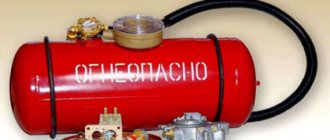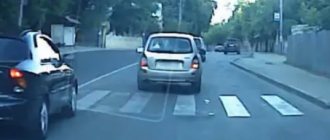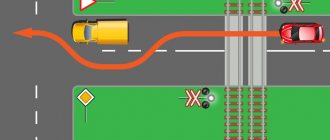Content:
- 1 Established standards
- 2 Shade strip selection
- 3 Selecting a shading strip
- 4 Self-adhesive film
- 5 Preparation
- 6 Film sticker
- 7 Advantages of tint film
Tinting a car in violation of established standards is fraught with a hefty fine. The film must be applied strictly in accordance with GOST, taking into account the level of shading and the area covered. And if at licensed service stations there are no questions regarding tinting, as well as according to standards, then when applying the sticker yourself, some problems may arise.
Tint strip on windshield
The essence of the violation
The likelihood of receiving a fine depends on the extent of the damage and the location of the cracks. The main argument for the illegality of driving with glass covered in chips, cracks and potholes is the deterioration of visibility. If there is only one crack, small and localized on the passenger side, the inspector is unlikely to pay attention to it. If there are many defects on the windshield on the driver's seat side, State Traffic Inspectorate employees may issue the driver a fine for a damaged windshield.
Why is a “web” of cracks dangerous:
- interferes with visibility;
- creates glare from headlights from oncoming traffic;
- distracts and disperses attention;
- The integrity of the glass may be compromised.
Established standards
If we are talking about a simple darkening strip running along the top of the windshield, then it should not be wider than 14 cm. This figure is clearly indicated in regulatory documents, but some motorists still have problems during control checks by traffic police officers.
Measuring the width of the film
The fact is that many people, when gluing tint, measure the required distance from the edge of the darkening strip, and not from the top border of the windshield. In addition, part of the film may move a few millimeters and fall outside the established standards.
In this case, the rules also contain instructions:
- the perimeter for sticking the strip is measured taking into account all 3 points;
- the specific width of the tint film is calculated taking into account the arithmetic mean of these data.
It happens that traffic police officers ignore these calculations, citing the fact that GOST seems to be in effect, but does not have any legislative force.
When applying a darkening strip, please note that a distance of 14 cm is the width of the tint across the entire windshield, and not just in the corners or in the center. In addition to the size, the level of shading should be taken into account.
The rules clearly state that the tint film must transmit 70% of the light. In fact, it looks almost transparent and visually merges with the windshield.
#8 24.03.2010 16:07:00
Deputy:
Fedotudalets, I also know that it is correct to measure vertically, and not along the plane of the glass, but the traffic police don’t know this, and I can’t find the norm of the law or GOST. Maybe you can help me find it?
copy: 4.7.2 The presence of cracks on the windshields of vehicles in the area where the windshield wiper cleans the half of the glass located on the driver’s side is not allowed.
4.7.3 It is not allowed to have additional objects or coverings that limit visibility from the driver’s seat (with the exception of rear-view mirrors, windshield wiper parts, external and radio antennas applied or built into the glass, heating elements of windshield defrosting and drying devices).
In the upper part of the windshield, it is allowed to mount a strip of transparent color film with a width of no more than 140 mm, and on vehicles of categories M_3, N_2, N_3 - with a width not exceeding the minimum distance between the upper edge of the windshield and the upper boundary of its cleaning zone with a windshield wiper. The light transmission of glass, including glass coated with transparent colored films, must comply with GOST 5727.
Edited by mad dog tony (03/24/2010 16:17:05)
Source
Selecting a Shade Strip
There are not as many problems with installing tint film as it seems at first glance. The main thing is to choose the strip itself wisely. On sale you can find solutions of standard size (14 cm) or those that go beyond the permitted limits: 16, 24 or 32 cm. There are also paired options, measuring 130 by 50 cm, designed for tinting the windshield and rear window.
Light transmission standards according to GOST
In addition to classical solutions, there are films with drawings or inscriptions. Yes, in some cases they blend harmoniously into the exterior of the car, but here it is important not to forget about the standards for light transmittance. If in one of the zones the picture turns out to be darker than required, then the traffic police officers will issue a fine, even if the rest of the area fits into the rules.
Types of stripes on the windshield
Do you need a stripe on your windshield?
There is an opinion among tinters that instead of gluing strips, it is better to tint the entire windshield. Even with a light film, with a light transmittance of 70%, so as not to violate the law too much.
The film will fulfill its main functions of protecting from ultraviolet radiation and from too bright sun. And the glare from the sun on the dashboard will be less. And from the inside such a film will be almost invisible, both day and night. Therefore, it will not interfere with the review at all. If you look at glass without film and glass with “70” from the inside, you can feel the difference. But, if you look from the outside at glass tinted with a film with 70% transparency, you can hardly say that it is tinted at all.
In general, whether to glue the strip on the windshield or not is your choice. You just have to remember that everything is good in moderation. The width of the strip is 14 cm - quite enough so that the direct rays of the sun do not dazzle the driver too much. And a strip of film covering half the glass is too much. This is not only unsightly, but also illegal.
Save
Selecting a Shade Strip
There are not as many problems with installing tint film as it seems at first glance.
The main thing is to choose the strip itself wisely. On sale you can find solutions of standard size (14 cm) or those that go beyond the permitted limits: 16, 24 or 32 cm. There are also paired options, measuring 130 by 50 cm, designed for tinting the windshield and rear window. In addition to classic solutions, there are films with drawings or inscriptions. Yes, in some cases they blend harmoniously into the exterior of the car, but here it is important not to forget about the standards for light transmittance. If in one of the zones the picture turns out to be darker than required, then the traffic police officers will issue a fine, even if the rest of the area fits into the rules.
Self-adhesive film
First of all, you need to choose the tint itself, taking into account the recommendations described above.
It’s better not to risk it and take it with a reserve: a 2-meter length should be enough for any passenger car. If there is a need to paste the rear or side windows, then we make the appropriate calculations. We definitely add 20-30 centimeters to the latter, just in case. Required materials and tools:
- construction spatula;
- spray;
- soap solution;
- regular stationery knife;
- hair dryer;
- microfiber.
Necessary tools and materials for tinting glass
It is better to find a spatula with a rubberized base so as not to scratch the glass. When preparing a soap solution, it is necessary to use boiled or settled water, because any, even tiny dirt can create unpleasant swelling under the tint.
Film application
Please note that you need to cut off the tint strip with a margin (5-7 cm more). The strip should only be applied to well-washed glass. Otherwise, the film will simply fall off. Next, the following actions are performed:
- the outside of the glass is treated with soapy water;
- carefully apply the film itself (make sure there are no air bubbles);
- excess pieces (2-5 cm) are cut off;
- The protective layer of the strip is removed with smooth movements, and at the same time the film is moistened with a soap solution from a spray bottle;
- on the inside, the glass is also moistened with a soap solution, and a film is applied;
- the material is leveled and adjusted (spare centimeters are immediately removed);
- use a non-sharp spatula to remove air bubbles;
- Use a technical hairdryer to thoroughly dry the surface.
Preparation
It is more advisable to carry out all work in a room with low humidity. If there is none, and the procedure will take place outdoors, then wait for warm and windless weather. Moisture that gets under the tint will cause streaks and peeling. The car needs to be washed and the areas where the film is applied should be treated with a soap solution. In difficult cases, you can use a special car shampoo or degreaser for smooth surfaces. Afterwards the glass must be dried with a hairdryer. Do not touch the clean surface with your hands or other objects, otherwise greasy stains may appear.
Film sticker
After the calculations have been made, we cut off the required piece of film.
It is important to make a small margin (5-7 cm) in case the strip accidentally moves in one direction or another. It is advisable to apply the film immediately after preparation, and not an hour later or, worse, the next day. The degreased area can absorb microscopic dirt, which will certainly make itself felt by swelling and stains, both during and after applying the tint. It would also be a good idea to wear gloves, preferably medical ones.
Film application:
- Degrease the outside of the glass.
- Carefully apply the tint.
- Remove air bubbles and stains.
- Remove the protective film, if any.
- Trim the protruding ends flush with the edges of the windshield.
- If necessary, we adjust the location of the film.
- Once again we pass over the surface with a spatula to get rid of any remaining air.
- Dry the surface with a hairdryer.
If the tinting is double-sided, then similar actions must be done inside the cabin. Ordinary solutions dry in about two days, while premium options can be used in just a few hours. All specifics regarding the performance qualities of the film must be indicated in the specification or instructions.
Applying the film to the windshield
After drying for these two days, do not adjust or touch the film. It is also not recommended to drive your car out in the rain or snow. It is better to leave the car in the garage while it dries. If weather permits, then in an open parking lot.
Advantages of tint film
Despite the strict restrictions on window tinting and the accompanying hefty fines, tinting has many clear advantages.
In addition to maintaining personal space, car enthusiasts highlight the following advantages:
- Protection of glass from physical damage.
- Slows down the spread of cracks and chips.
- Protection of passengers and plastic elements of the interior from direct sunlight.
- In the summer months, the coolness accumulated overnight is retained, and in the winter months, the heat is saved.
- Tinting protects the driver from being blinded by the headlights of oncoming cars.
In car dealerships you can find special devices that determine the level of light transmission, which allows you to control the regulatory part of the issue. Service stations and, naturally, traffic police officers have similar devices.
What are the inspectors referring to?
Traffic police officers argue for the existence of an offense, referring to the first part of Art. 12.5 Code of Administrative Offences. It contains a ban on driving a car with defects that could create emergency situations on the roads. Violation of the integrity of the windshield on the driver's side, impairing visibility can be attributed to such malfunctions. The fine for a damaged windshield in 2021 is 500 rubles. Confiscation of a driver's license or detention of a car in this case is not legal.










